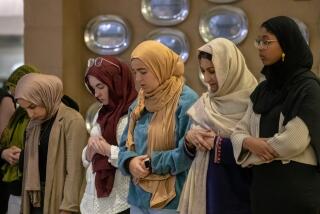U.S. satellite spies holiday lights from space
Americans are serious about their Christmas lights -- so much so that a NASA satellite can see them from space.
The Suomi National Polar-orbiting Partnership satellite, which NASA operates with the National Oceanic and Atmospheric Administration, can’t see the individual lights that adorn the Rockefeller Center or the yachts in the Newport Beach Christmas Boat Parade. But the satellite can certainly tell that the total amount of nighttime light emitted during the holiday season is as much as 50% greater than during the rest of the year.
The Suomi satellite wasn’t designed to measure the wattage of Christmas displays, of course. It was launched in 2011 to study Earth’s cloud cover, vegetation, ice, ozone layer and air pollution, as well as to monitor the temperature on land, at sea and in the atmosphere, among other things.
The satellite’s Visible Infrared Imaging Radiometer Suite, or VIIRS, instrument does its part by recording visible and infrared light from all over the globe. The stunning “Earth at Night” images were made with VIIRS data.
Researchers from NASA’s Goddard Space Flight Center and Yale University were part of a team that developed an algorithm to help them see whether these lights changed much from night to night. The researchers were expecting the lights to be pretty stable, but when they examined images of Cairo, they found a surprising blip.
After some digging, they realized that the brighter lights corresponded with the holy month of Ramadan -- a period when Muslims fast during the day and gather to eat after the sun sets. Ramadan starts about a week and a half earlier every year. Sure enough, the changes in nighttime light in Cairo synced up with the Islamic calendar.
Then they turned their attention to cities in the United States. They had to focus on places without snow, since snow reflects too much light. In the cities they did analyze, they corrected for the light effects of clouds, aerosols and even the reflection of the moon.
The researchers created images to compare the light output during the holiday season with the light measured during the rest of the year. The greater the increase, the greener an area appears. In cities such as Atlanta, Dallas, Houston, Los Angeles, Miami, Phoenix, Sacramento and San Jose, the nighttime light during the weeks between Black Friday and New Year’s Day rose by as much as 50%.
The changes weren’t uniform throughout these metropolitan areas. In general, central urban areas got about 20% to 30% brighter, while light in the suburbs got 30% to 50% more intense.
“We were really surprised to see this vibrant increase in activity during the holidays, and particularly around areas in the suburbs where you have a lot of single family homes with a lot of yard space to put lights,” Miguel Roman, a research physical scientist at Goddard Space Flight Center, said in a NASA video. The light maps provide clues that Americans leave the cities and head to the suburbs and more rural areas during the holidays, he added.
Roman and his colleagues noticed a different pattern in the Ramadan lights. Unlike in the United States, people in the Middle East didn’t tend to travel much during the holy month.
“The communities are staying where they are and they’re shifting their activities to the night,” Roman said.
But some communities did this more than others. Relying on the satellite data alone, it’s possible to tell that Ramadan is a bigger deal in Saudi Arabia than in Turkey, and that it’s not a factor in Israel.
“We’re seeing patterns of behavior that vary significantly from country to country,” Roman said.
The light measurements were so precise that Roman and Eleanor Stokes, a NASA fellow and Yale graduate student, were able to compare different neighborhoods within Cairo. Some neighborhoods saw no uptick in light use during most of Ramadan, including areas where residents are devout but poor. However, when it was time to celebrate Eid al-Fitr at the end of Ramadan, light output spiked throughout the city.
“By looking at the lights, we can see changes in human behavior,” Roman said. “We can use that information to then understand what are the norms that are driving the decision behind energy.”
The research was presented this week at the fall meeting of the American Geophysical Union in San Francisco.
If science brightens your day (and night), follow me on Twitter @LATkarenkaplan and “like” Los Angeles Times Science & Health on Facebook.







